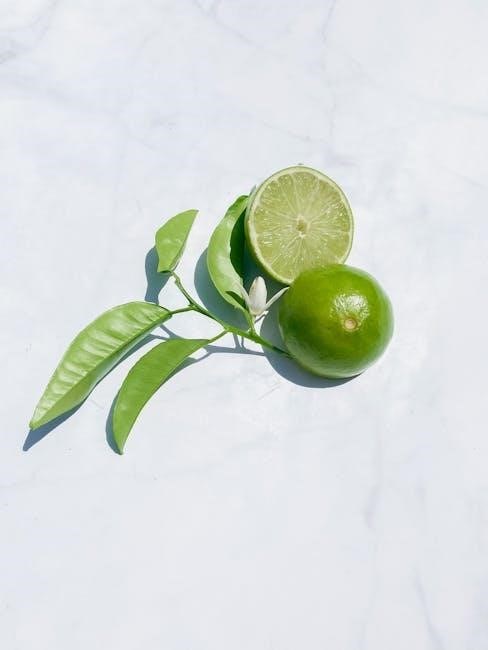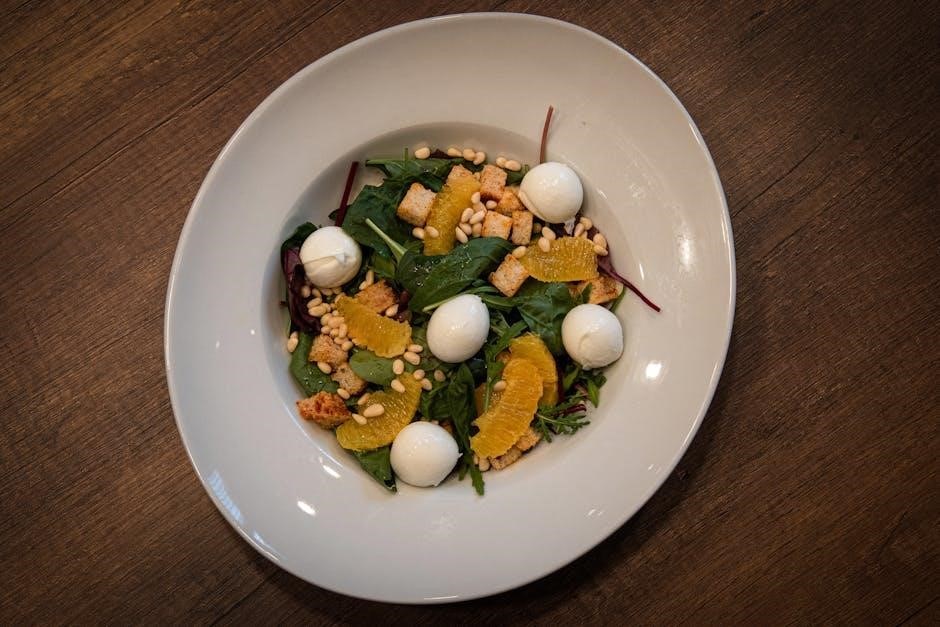What Are Alkaline Foods?
Alkaline foods are natural foods that help maintain the body’s pH balance by neutralizing acidity. They include vegetables‚ fruits‚ nuts‚ and herbs rich in essential nutrients.
Alkaline foods are natural foods that help neutralize acidity in the body‚ promoting a balanced pH level. They include vegetables‚ fruits‚ nuts‚ seeds‚ and herbs rich in essential nutrients. Examples are leafy greens like spinach and kale‚ citrus fruits such as lemons‚ and other alkaline-forming foods like avocados‚ berries‚ and almonds. These foods are known for their ability to reduce acidity and support overall health‚ making them a key component of a balanced diet.
Importance of Alkaline Foods in the Diet
Alkaline foods are crucial for maintaining the body’s pH balance‚ which is essential for optimal health; They help neutralize acidity‚ reducing the risk of chronic diseases like osteoporosis and supporting weight management. By incorporating alkaline-rich foods such as leafy greens‚ citrus fruits‚ and nuts‚ individuals can enhance their energy levels‚ improve digestion‚ and reduce inflammation. A diet rich in alkaline foods promotes overall vitality and supports long-term well-being by fostering a balanced internal environment.

Benefits of Alkaline Foods
Alkaline foods boost energy‚ reduce inflammation‚ and support weight loss. They help manage chronic pain‚ alleviate muscle soreness‚ and prevent osteoporosis‚ enhancing overall health naturally.
Weight Loss and Management
Alkaline foods play a significant role in weight loss by reducing acidity and promoting a balanced metabolism. They help suppress cravings for unhealthy snacks and improve digestion. Incorporating leafy greens‚ citrus fruits‚ and berries into your diet can enhance fat burning and support long-term weight management. A diet rich in alkaline-forming foods also reduces inflammation‚ which is often linked to weight gain. By focusing on natural‚ nutrient-dense options‚ individuals can achieve and maintain a healthy weight more effectively.
Chronic Pain Management
Incorporating alkaline foods can aid in chronic pain management by reducing inflammation‚ a key contributor to discomfort. Leafy greens like spinach and kale‚ along with citrus fruits‚ help alkalize the body‚ potentially easing pain symptoms. Alkaline-forming foods promote a balanced pH‚ which may reduce inflammation and improve overall well-being‚ offering a natural approach to managing chronic pain effectively.
Muscle Soreness Relief
Alkaline foods can help alleviate muscle soreness by reducing inflammation and acidity in the body. Foods like spinach‚ berries‚ and avocados are rich in antioxidants and minerals that promote muscle recovery. Incorporating alkaline-forming foods into your diet may help neutralize lactic acid buildup‚ easing muscle discomfort and improving overall mobility. This natural approach supports post-workout recovery and enhances physical performance.
Osteoporosis Prevention
Alkaline foods play a crucial role in osteoporosis prevention by promoting calcium retention and bone health. Leafy greens like kale and spinach‚ rich in magnesium and calcium‚ strengthen bones. Alkaline-forming foods help neutralize acidity‚ reducing the body’s need to leach calcium from bones. Incorporating these foods supports bone density‚ lowering the risk of fractures and osteoporosis. A diet rich in alkaline-forming vegetables and fruits is essential for maintaining strong‚ healthy bones throughout life.

The Acid-Alkaline Food Chart
The Acid-Alkaline Food Chart categorizes foods based on their pH levels‚ helping guide dietary choices. It lists alkaline-forming foods like kale and spinach‚ and acidic foods like meat and dairy‚ promoting balance for optimal health.
Highly Acidic Foods
Highly acidic foods include red meat‚ poultry‚ fish‚ eggs‚ dairy products‚ and processed items. These foods can lower the body’s pH‚ potentially leading to health issues if consumed excessively. Examples like ground beef‚ chicken breast‚ and cheddar cheese are noted for their high acid-forming properties. Refined grains‚ sugary snacks‚ and alcoholic beverages also fall into this category. While some acidic foods are necessary for nutrition‚ overconsumption can disrupt the body’s natural balance‚ emphasizing the importance of moderation and a balanced diet.
Highly Alkaline Foods
Highly alkaline foods are rich in essential minerals like calcium‚ magnesium‚ and potassium‚ which help neutralize body acidity. Leafy greens such as spinach‚ kale‚ and collard greens are among the most alkaline. Citrus fruits like lemons and oranges‚ despite their acidic taste‚ are highly alkalizing. Other examples include broccoli‚ cucumbers‚ and chlorella. Incorporating these foods into your diet can promote a balanced pH‚ support overall health‚ and reduce the risk of chronic conditions. They are versatile and can be easily added to meals for optimal benefits.
Moderately Alkaline Foods
Moderately alkaline foods provide a balanced way to support your body’s pH levels. Examples include apples‚ apricots‚ and asparagus‚ which are rich in antioxidants and fiber. Carrots‚ celery‚ and sweet peppers also fall into this category. These foods are less potent than highly alkaline options but still offer significant health benefits. Incorporating them into meals helps maintain a healthy balance‚ making them a practical choice for everyday nutrition. They are versatile and can be easily integrated into various recipes to enhance both flavor and nutritional value.

Understanding the 70/30 Ratio
The 70/30 ratio recommends consuming 70% alkaline-forming foods and 30% acidic foods to maintain optimal pH balance‚ promoting overall health and energy levels naturally.
What Is the 70/30 Ratio?
The 70/30 ratio is a dietary guideline suggesting 70% of meals should consist of alkaline-forming foods‚ such as vegetables‚ fruits‚ and nuts‚ while 30% can be acidic foods like meats and grains. This balance helps maintain the body’s pH level‚ reducing acidity and promoting health. Many resources‚ including PDF charts‚ provide detailed lists to help individuals plan meals adhering to this ratio‚ ensuring a balanced and nutritious diet.
How to Achieve the 70/30 Balance
Achieving the 70/30 balance involves prioritizing alkaline-forming foods like vegetables‚ fruits‚ nuts‚ and seeds‚ while limiting acidic foods such as meats‚ dairy‚ and grains. Start by incorporating leafy greens‚ citrus fruits‚ and alkaline-rich snacks into meals. Use a food chart or guide to identify and categorize foods. Plan meals in advance to ensure the ratio is maintained‚ and gradually reduce acidic food intake. This balanced approach promotes optimal health and supports the body’s natural pH equilibrium‚ making it easier to adopt a sustainable diet.

Alkaline-Forming Vegetables
Leafy greens like kale‚ spinach‚ and broccoli are highly alkaline; Vegetables such as bell peppers‚ asparagus‚ and cucumbers also promote alkalinity‚ supporting overall health and balance.
Leafy Greens
Leafy greens are a cornerstone of alkaline-forming vegetables‚ offering rich nutritional benefits. Kale‚ spinach‚ collard greens‚ and watercress are top choices‚ high in vitamins and minerals. These greens help maintain pH balance‚ support weight loss‚ and reduce inflammation. Incorporating them into salads‚ smoothies‚ or sautéed dishes enhances overall health. Their alkaline properties make them essential for balancing acidic diets and promoting well-being. Regular consumption supports energy levels and detoxification processes‚ making leafy greens a vital addition to any alkaline-focused diet.
Cruciferous Vegetables
Cruciferous vegetables like broccoli‚ Brussels sprouts‚ and cauliflower are highly alkaline‚ aiding in detoxification and reducing inflammation. They are rich in antioxidants and fiber‚ which support digestion and overall health. These vegetables are known to promote a balanced pH level‚ making them a key component in alkaline diets. Incorporating them into meals helps neutralize acidity and supports weight management. Their alkaline properties also contribute to chronic pain relief and improved bone health‚ making them a valuable addition to daily nutrition.
Other Alkaline Vegetables
Beyond leafy greens and cruciferous varieties‚ other alkaline vegetables include beets‚ cucumbers‚ carrots‚ and celery. These vegetables are rich in minerals like calcium‚ magnesium‚ and potassium‚ which help neutralize acidity in the body. Beets support detoxification‚ while cucumbers and celery are hydrating and alkaline-forming. Carrots are high in alkaline properties and antioxidants‚ promoting overall health. Incorporating these vegetables into meals aids in balancing pH levels‚ supporting weight management‚ and reducing inflammation. They are versatile and can be easily added to salads‚ juices‚ or snacks for a healthy‚ alkaline diet.
Alkaline-Forming Fruits
Alkaline-forming fruits include citrus varieties like lemons‚ oranges‚ and grapefruits‚ as well as avocados‚ berries‚ and tropical options like mangoes and pineapples. These fruits help reduce acidity and promote overall health by providing essential vitamins and minerals.
Citrus Fruits
Citrus fruits like lemons‚ oranges‚ and grapefruits are highly alkaline-forming. Despite their acidic taste‚ they help neutralize body acidity. They are rich in vitamin C‚ flavonoids‚ and antioxidants‚ supporting immune function and detoxification. Regular consumption can aid in balancing pH levels and improving overall health. Incorporating these fruits into your diet is a simple way to enhance alkalinity and enjoy numerous nutritional benefits. They are versatile and can be consumed as juice‚ added to meals‚ or eaten raw for optimal effect.
Other Alkaline Fruits
Beyond citrus‚ other alkaline fruits include avocados‚ berries‚ and tropical options like mangoes and pineapples. Avocados are rich in healthy fats and minerals‚ while berries provide antioxidants. These fruits support alkalinity by reducing inflammation and promoting a balanced pH. Incorporating them into meals or snacks helps maintain overall health and vitality. Their versatility makes them easy to add to diets‚ enhancing both nutrition and taste naturally.
Alkaline-Forming Proteins
Plant-Based Proteins
Alkaline-forming proteins include plant-based options like lentils‚ quinoa‚ and tofu. These foods are rich in nutrients and help maintain the body’s pH balance naturally.
Plant-based proteins are excellent alkaline-forming foods. Lentils‚ tofu‚ quinoa‚ and tempeh are rich in nutrients and promote a healthy pH balance. These options are versatile and easily incorporated into meals‚ making them ideal for maintaining an alkaline diet. They provide essential amino acids and support overall wellness without causing acidity. Including these proteins in your diet can help neutralize acidity and improve energy levels. They are also environmentally friendly and offer numerous health benefits‚ making them a great choice for those seeking balanced nutrition.
Fish and Poultry
Fish and poultry can be part of an alkaline diet when consumed in moderation. Salmon and freshwater fish are mildly alkaline‚ while chicken breast and lean meats are less acidic. These proteins provide essential nutrients like omega-3 fatty acids and lean protein‚ supporting muscle health and energy. Proper portion control and pairing with alkaline-rich foods help maintain balance‚ ensuring they contribute positively to overall health without causing acidity;
Alkaline-Forming Grains
Whole grains like quinoa‚ brown rice‚ and amaranth are alkaline-forming‚ providing essential fiber and minerals. They support digestion and overall health‚ making them a great dietary choice.
Whole Grains
Whole grains such as quinoa‚ brown rice‚ and amaranth are excellent alkaline-forming foods. They are rich in fiber‚ vitamins‚ and minerals‚ promoting digestion and overall well-being. These grains help balance the body’s pH levels naturally. Incorporating them into meals supports a healthy alkaline diet and provides sustained energy. Examples include millet‚ buckwheat‚ and Kamut‚ which are also gluten-free options for those with dietary restrictions. These grains are versatile and can be used in various dishes‚ making them a great addition to an alkaline-based lifestyle.
Gluten-Free Options
Gluten-free grains like quinoa‚ millet‚ and buckwheat are ideal for an alkaline diet. These options are naturally free from gluten and rich in nutrients. They promote pH balance and support digestion. Incorporating gluten-free grains helps maintain energy levels and overall health. Alkaline-friendly choices include amaranth and Kamut‚ which are versatile for various recipes. These grains are perfect for those with dietary restrictions‚ ensuring a balanced and nutritious alkaline-based diet. They are widely recommended for their health benefits and ease of preparation.
Alkaline-Forming Nuts and Seeds
Nuts
Nuts like almonds‚ cashews‚ and walnuts are alkaline-forming. They provide essential fats‚ proteins‚ and minerals‚ supporting overall health and pH balance.
Seeds
Seeds such as chia‚ flax‚ and pumpkin are highly alkaline. They are rich in omega-3s‚ fiber‚ and antioxidants‚ benefiting digestion and energy levels.
Nuts are excellent alkaline-forming foods. Almonds‚ cashews‚ and walnuts are top choices‚ offering healthy fats‚ proteins‚ and minerals. They help maintain pH balance and support overall health. Rich in antioxidants‚ nuts reduce inflammation and promote well-being. Incorporating them into meals or snacks aids digestion and energy levels‚ making them a nutritious addition to an alkaline diet. Moderation is key due to their calorie content‚ ensuring a balanced intake for optimal benefits.
Seeds are highly alkaline and packed with nutrients. Chia‚ flax‚ and pumpkin seeds are top choices‚ offering omega-3s‚ fiber‚ and minerals. They support pH balance‚ reduce inflammation‚ and improve digestion. Incorporate them into meals or smoothies for enhanced health benefits. Seeds are versatile and nutritious‚ making them a great addition to an alkaline diet. Their small size belies their big impact on overall well-being and energy levels. Moderation is key‚ but they provide significant advantages when included regularly. Seeds are a natural way to boost your alkaline intake effectively. They are essential for a balanced diet and long-term health.

Alkaline-Forming Beverages
Alkaline beverages like alkaline water‚ herbal teas‚ and fresh vegetable juices help neutralize body acidity and promote hydration. They are essential for maintaining pH balance and overall health.
Alkaline Water
Alkaline water has a higher pH level than regular water‚ typically between 8 and 9.5‚ due to its mineral content‚ such as calcium and magnesium. It helps neutralize body acidity‚ promoting better hydration and digestion. Many believe it supports overall health by reducing acidity and enhancing nutrient absorption. Alkaline water can be naturally sourced or created using filters that add minerals. Incorporating it into a balanced diet may aid in maintaining the body’s pH equilibrium‚ though moderation is key‚ as excessive alkalinity can disrupt digestive balance.
Herbal Teas
Herbal teas‚ such as peppermint‚ chamomile‚ and hibiscus‚ are alkaline-forming beverages that support overall health. They are naturally caffeine-free and rich in antioxidants‚ which help reduce inflammation and improve digestion. Many herbal teas are known for their calming effects and ability to promote hydration without adding acidity to the body. Incorporating these teas into your diet can enhance your alkaline intake and contribute to a balanced 70/30 ratio of alkaline to acid-forming foods‚ supporting long-term well-being and vitality.

Alkaline-Forming Herbs and Spices
Herbs and spices like basil‚ cumin‚ turmeric‚ and ginger are alkaline-forming‚ enhancing flavor while promoting pH balance. They are versatile and boost both nutrition and taste in meals.
Common Herbs
Common herbs such as basil‚ parsley‚ cilantro‚ and dill are highly alkaline-forming‚ offering numerous health benefits. These herbs not only enhance flavor in meals but also help neutralize acidity in the body. Basil‚ for instance‚ is rich in antioxidants and supports digestion. Parsley is known for its detoxifying properties and high vitamin C content. Incorporating these herbs into daily dishes can promote pH balance and overall well-being. They are versatile‚ easy to add to salads‚ soups‚ and sauces‚ making them a great way to boost alkalinity naturally.
Common Spices
Common spices like turmeric‚ ginger‚ and cinnamon are highly alkaline-forming and offer numerous health benefits. Turmeric‚ known for its anti-inflammatory properties‚ supports immune function and detoxification. Ginger aids digestion and reduces inflammation‚ while cinnamon helps stabilize blood sugar levels. These spices not only enhance the flavor of meals but also contribute to a balanced pH level. Incorporating them into daily cooking can naturally promote alkalinity and improve overall well-being. Their versatility makes them easy to add to soups‚ teas‚ and baked goods for enhanced nutrition and flavor.

Implementing the Alkaline Diet
Implementing an alkaline diet involves focusing on alkaline-rich foods‚ staying hydrated with alkaline water‚ and planning meals around seasonal‚ organic ingredients. Balance is key to achieving optimal health benefits.
Meal Planning Tips
Planning meals around alkaline foods is essential for maintaining balance. Start with a 70/30 ratio of alkaline to acidic foods. Incorporate leafy greens‚ citrus fruits‚ and nuts into meals. Use alkaline-forming vegetables like spinach and broccoli as bases for dishes. Add herbs and spices to enhance flavor without acidity. Meal prep with salads‚ smoothies‚ and roasted vegetables for convenience. Stay hydrated with alkaline water and herbal teas. Limit processed foods and dairy‚ opting for whole‚ organic ingredients instead. Refer to a PDF chart for easy planning and grocery lists.
Snacking Strategies
Snacking on alkaline-rich foods is a great way to maintain balance throughout the day. Opt for fresh fruits like berries‚ citrus‚ or apples‚ and crunchy vegetables such as carrots or cucumbers. Nuts and seeds‚ such as almonds and chia seeds‚ are excellent alkaline snacks. Keep a bowl of trail mix with alkaline-forming ingredients handy. For quick options‚ try vegetable sticks with hummus or a green juice. Refer to a PDF chart for more snack ideas. Avoid processed snacks and choose whole‚ nutrient-dense options to support your health journey.
- Nuts and seeds
- Fresh fruits
- Raw vegetables
- Herbal teas

Resources for Alkaline Foods
Download a PDF chart from Alkalife‚ listing alkaline and acidic foods with ratings. Based on Dr. Young’s research‚ it helps plan a balanced diet easily.
PDF Charts and Guides
Downloadable PDF charts‚ like those from Alkalife‚ provide detailed lists of alkaline and acidic foods with their pH ratings. Based on Dr. Young’s research‚ these guides categorize foods such as vegetables‚ fruits‚ and grains. They often include practical tips for meal planning and maintaining the ideal 70/30 ratio. Printable charts are ideal for quick reference‚ helping you make informed dietary choices. These resources are essential for anyone aiming to balance their diet and improve overall health. Download a PDF chart today for easy access to alkaline food lists.
Online Tools and Apps
Utilize online tools and apps like Alkaline Diet Assistant or pH Balance Tracker to easily identify alkaline and acidic foods. These apps provide comprehensive food databases‚ barcode scanners‚ and meal planners. They help track your daily intake and offer personalized recommendations to achieve the 70/30 balance. Features include customizable lists‚ reminders‚ and community support. Download apps like Alkaline Food Tracker to simplify your journey toward a balanced diet. These digital resources are perfect for maintaining health and wellness on the go.
Alkaline foods are crucial for maintaining pH balance‚ promoting health‚ and preventing diseases. Aim for a 70/30 balance in your diet. Use alkaline food charts for guidance.
Final Thoughts on Alkaline Foods
Alkaline foods are essential for maintaining optimal health by balancing the body’s pH levels. Incorporating vegetables‚ fruits‚ and nuts into your diet can help reduce acidity and promote well-being. A list of alkaline foods PDF serves as a practical guide‚ offering clarity on which foods to prioritize. By focusing on alkaline-forming options‚ individuals can support their body’s natural functions‚ enhance energy levels‚ and reduce the risk of chronic conditions. Balancing your diet with these foods fosters long-term health and vitality‚ making it a worthwhile commitment for overall wellness.
Encouragement for a Balanced Diet
Embracing a balanced diet rich in alkaline foods can significantly enhance your health. Start by incorporating leafy greens‚ citrus fruits‚ and nuts into your meals. Referencing a list of alkaline foods PDF can simplify your transition‚ offering clear guidelines. Even small changes‚ like adding a serving of broccoli or swapping acidic grains for whole ones‚ can make a difference. Consistency is key; gradual shifts often lead to sustainable‚ positive outcomes for your well-being and energy levels. Small steps today can pave the way for a healthier tomorrow.

References
Scientific studies and expert recommendations highlight the benefits of alkaline foods. Dr. Robert Young’s research and resources like the alkaline foods PDF chart provide valuable insights.
Scientific Studies
Scientific research supports the benefits of alkaline-forming foods. Studies by Dr. Robert Young and others highlight how foods like leafy greens and citrus fruits promote pH balance. The PRAL (Potential Renal Acid Load) list‚ referenced in the alkaline foods PDF chart‚ classifies foods based on their acid-forming or alkaline-forming properties. These findings are widely used by nutritionists and researchers to recommend diets that reduce chronic acidity and improve overall health. The studies emphasize the importance of balancing alkaline and acidic foods for optimal wellness.
Expert Recommendations
Nutritionists and health experts recommend incorporating alkaline-forming foods into your diet to maintain optimal pH balance. Aiming for a 70/30 ratio of alkaline to acidic foods is often suggested. Leafy greens‚ citrus fruits‚ and vegetables like broccoli and spinach are highly recommended. Avoid excessive consumption of acid-forming foods such as meat‚ dairy‚ and processed grains. Consulting a list of alkaline foods PDF can help plan balanced meals. Experts also advise monitoring your body’s response and adjusting your diet accordingly for improved health outcomes.


